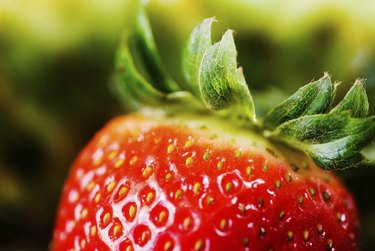
One in 10 Americans over the age of 40 develops a chronic gastrointestinal disorder known as diverticulosis, according to the National Institute of Diabetes and Digestive and Kidney Diseases. After years of a low-fiber diet, most medical experts believe, chronic constipation and straining to have a bowel movement creates diverticula, which are small pouches that bulge outward at weak spots along your colon. About 20 percent of adults with chronic diverticulosis experience acute flare-ups known as diverticulitis when these pouches become inflamed or infected. Foods with seeds are forbidden during a diverticulitis attack, but talk to your doctor for guidance regarding what specific dietary changes would be most suitable for your particular situation.
Rationale
Video of the Day
Seeds from fruits, vegetables and grains are high in fiber. You can enjoy these foods during the chronic phase of your diverticular disease, when high-fiber foods help control symptoms and avoid diverticulitis attacks. Once you develop the abdominal pain, nausea, vomiting, fever, chills, cramping and constipation associated with diverticulitis, you should stop eating seeds. Your doctor will recommend a clear liquid diet for two to three days to give your colon a chance to rest. Once your symptoms improve, you can slowly add low-fiber foods back into your diet, but you should still avoid foods with seeds until your diverticulitis flare-up is over, explains the University of California at San Francisco Medical Center, or UCSF.
Video of the Day
Fruits with Seeds
When you're on a low-fiber diet for diverticulitis, stay away from cherries, blueberries, raspberries, blackberries, strawberries and other types of berries. Avoid dried fruits, such as dates, figs, prunes, apricots and raisins. Eliminate raw fruits that have skins and seeds, such as apples, plums and pears.
Vegetables with Seeds
Legumes such as dried beans, peas and lentils are high-fiber pods that contain seeds. Don't eat baked beans, kidney beans, split peas, dried beans, garbanzo beans, pinto beans, black beans or other legumes while you're on a low-fiber diet. Stay away from fresh or frozen green peas, pole beans or snap beans. Avoid fresh or frozen corn, tomatoes, cucumbers and squash, primarily because of seeds and skins. Once your symptoms subside you can slowly add these items back into your diet.
Grains and Cereal with Seeds
You can eat enriched white bread or low-fiber cereal while you're recovering from diverticulitis, but don't select whole-grain products. Avoid breads and cereals that contain seeds, such as pumpkin, caraway, sesame, rye and sunflower seeds. You can have limited amounts of white rice, but don't eat brown or wild rice.
Meat and Meat Alternatives with Seeds
While you can safely ingest 2- to 3-ounce servings of tender, well-cooked meat, fish or poultry on a low-fiber diet, stay away from meat dishes that contain seeds. Avoid protein sources that contain caraway, dill, sesame or other seeds for flavoring. Eliminate breaded entrees that may contain whole grains with seeds. The University of Maryland Medical Center also recommends you avoid red meat.
- National Institute of Diabetes and Digestive and Kidney Diseases: Diverticulosis and Diverticulitis
- University of California at San Francisco Medical Center: Diverticular disease and Diet
- University of Maryland Medical Center: Diverticular Disease
- Drugs.com: Low-Fiber Diet
- Continuum Health Partners: Bowel Function & Dietary Fiber
- Cleveland Clinic: Diverticulosis and Diverticulitis
- Medline Plus: Diverticulitis